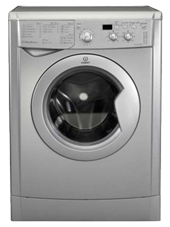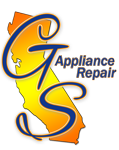Washing Machine Repair Guide
 For the DIY-inclined, the below guides will assist in completing simple repairs on your washing machine. It is impossible to write guides applicable for every model of washing machine, so in some cases there may be additional steps required to complete repairs.
For the DIY-inclined, the below guides will assist in completing simple repairs on your washing machine. It is impossible to write guides applicable for every model of washing machine, so in some cases there may be additional steps required to complete repairs.
DISCLAIMER: Appliance Repair can be dangerous, especially when dealing with electricity. The electrical current generated from wall outlets can be enough to kill someone. Please exercise extreme caution when working with appliances. GSAR cannot be held liable for injuries due to misuse of our repair guides.
How to Remove Odor from Front-Loading Washing Machines
Front-loading washing machines require special attention for sanitation to avoid developing odors. By following these steps, you can reduce or even eliminate the odor emanating from your washing machine:
- Make sure to leave the door open after each cycle. This is necessary because mold growth occurs in enclosed, wet environments.
- Purchase a product such as Affresh, Tide Washing Machine Cleaner, or Smelly Washer® Cleaner. These products can be found in most grocery stores, or you may purchase them online. Golden State Appliance Repair’s recommendation is Affresh.
- Run a hot water cycle with one of the above products to break down any odorous debris inside of your washing machine. If your front-load has a cleaning cycle, that’s even better.
- Purchase a 1 gallon jug of white vinegar. Pour about half of the jug in the washing machine’s tub, and then run the washer’s hottest cycle or cleaning cycle if applicable. Don’t get into the habit of using white vinegar on a regular basis — extended use can result in damaging the rubber parts of your washing machine.
- For particularly difficult odors, leave the door open and remove the detergent drawer. Leave the washing machine in this condition for at least 5 days. This will allow time for odorous debris to flake off and be rinsed away with your next cycle. To expedite the process, you may position a fan blowing into your washing machine’s tub for 3 days.
- Repeat step 3.
- Wipe down your door gasket — the rubber seal between the door and tub of your washing machine. Use antibacterial wipes or a bleach-based bathroom cleaner. Particularly smelly or mold damaged door gaskets may need to be replaced.
- Wipe down the inside of your door with a damp rag.
How to Remove Odor from Top-Loading Washing Machines
Top-loading washing machines can develop odors much in the same way that front-loading washing machines do. Odorous top-loading washing machines are less common, but just as aggravating to deal with. Here’s how to resolve odors from your top-loader:
- Every so often you should be using a cleaner product like Affresh, Tide Washing Machine Cleaner, or Smelly Washer® Cleaner.
- Under the lid you can sometimes visibly see the lip of the tub, which is a plastic piece that is usually white in color. You should keep this clean using antibacterial wipes or a rag with some bleach-based bathroom cleaner. This plastic piece can also be removed for a more complete wash. Depending on the washing machine, you may need a tool to remove this piece.
- Some machines have a cap on the agitator for fabric softener. This can easily be popped off and cleaned. Below this, you can sometimes access part of the inside of the agitator to can clean that as well.
- With a little bit of skill you can remove the agitator completely to allow a full and more thorough cleaning of the agitator and inside of the basket. This sometime can require tools to complete.
- Using cold water is a good idea to save on energy, but running a hot water cycle on occasion helps to break down odorous residue inside of your washing machine.
- Leaving your washing machine alone for a few days may help to resolve the odor because odorous bits will begin to flake off and may rinse out during the drain cycle.
How to Fix a Front Loading Washing Machine That Won’t Drain or Spin
This is one of the more common requests we hear from our customers. Here’s how to get your washing machine back to normal:
- Run the spin cycle (or drain/spin cycle) by itself. If you hear a clanking noise, stop the washing machine immediately and call a repair professional. If you don’t, it’s likely that you have an obstructed pump or drain hose — proceed to the next step!
- If you have an accessible lower panel or access to a visible coin trap, these may need to be cleaned out. If you don’t have an access panel, skip to step #9. The coin-trap is usually behind the lower panel door on the lower part of the washing machine. The coin-trap housing is usually an off-white color. The coin-trap is basically a plastic filter.
- Siphon the visible water or get a small cup and a bucket to extract the water from the tub.
- When unscrewing the coin-trap, be careful: there is will still be some residual water in the machine even after the previous step. Place a shallow pan — a baking pan works well — under the coin-trap opening. Slowly unscrew the coin-trap counter-clockwise, releasing the remaining water until the water stops flowing.
- The coin trap can now be completely removed.
- Once the coin trap has been cleaned, wipe down the coin trap opening completely before reassembling.
- Ensure the coin trap is tightened clockwise.
- If the washing machine has a drain/spin cycle, run just that cycle. You must get water back in the washer to see if it drains properly. If it drains properly you may have been successful. If not, you may need to call an appliance technician.
- If the washing machine doesn’t have an accessible lower panel, it can become very difficult to access the pump housing, coin-trap, or plastic filter. If this is the case, you may need to call an appliance technician.
- It’s very rare for the drainage hose to have an obstruction. If the washing machine still will not spin or drain, this is the last thing to check as it is the least likely.

